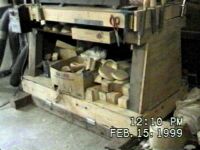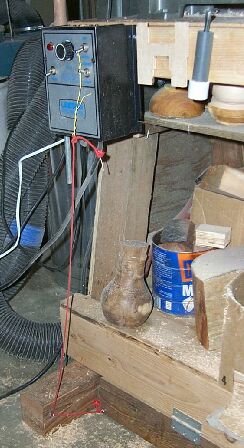 |
This is my lathe stand. The top is made from glued
up 2"x4" boards with a thin piece of plywood on top to sorta even out the
surface. It is held to the legs with some 3" angle iron.
I used some 4"x4" stock for the legs. The legs are angled in about 10 degrees (give or take), and are connected with half lap joints. I sheathed the ends and back with plywood for shear strength. I also added a shelf about 6" below the top to hold odds and ends. Note the strip of flashing - its for ripping sandpaper to size. I've also used a bunch of 6" pieces of pvc pipe as tool holders. |
| It's probably safe to say that anybody
who's been turning for very long has had a blank come loose while under
power which presents a safety hazard. It is a great advantage to
be able to instantly turn off your lathe without having to reach past the
flight path of a loose blank. Mike Paulson, a professional woodturner
in Fort Collins, Colorado, showed me this simple but very effective way
to stop the lathe quickly and without risk by using a kickplate.
While a great safety feature, it is also a very convenient way to turn
off the lathe in the normal course of a project as well since your hands
are often full. Best of all, it costs next to nothing and is easily
implemented.
To begin with, I drilled a small hole in the toggle switch on my lathe. (A Dremel or similar tool works great for this.) Through this, I threaded some stout fishing line, which was in turn connected to a bungee cord. (The photo shows some wire and cotton cord - I upgraded to the fishing line and bungee later). The cord runs down the leg of my lathe stand and through a couple of small eye bolts, terminating at a 2x4 which runs the length of my lathe stand. The 2x4 is attached with a pair of hinges, allowing it to swing. When the lathe is switched on, the cord pulls the board out just slightly. When the board is tapped with your foot, it swings in, pulling the cord and turning off the lathe. I put stop blocks just behind it to prevent it from swinging in too far and stressing the toggle switch. |

Altogether, I didn't spend more than a couple of dollars and an hour or two but my lathe is significantly safer for it, and that's invaluable! |
| Closed Forms | Canisters | Bowls | Misc. Thingies |
|
|
|
|
| The Shopsmith Years | Home | The Family & Stuff | Cool Links (IMHO) |